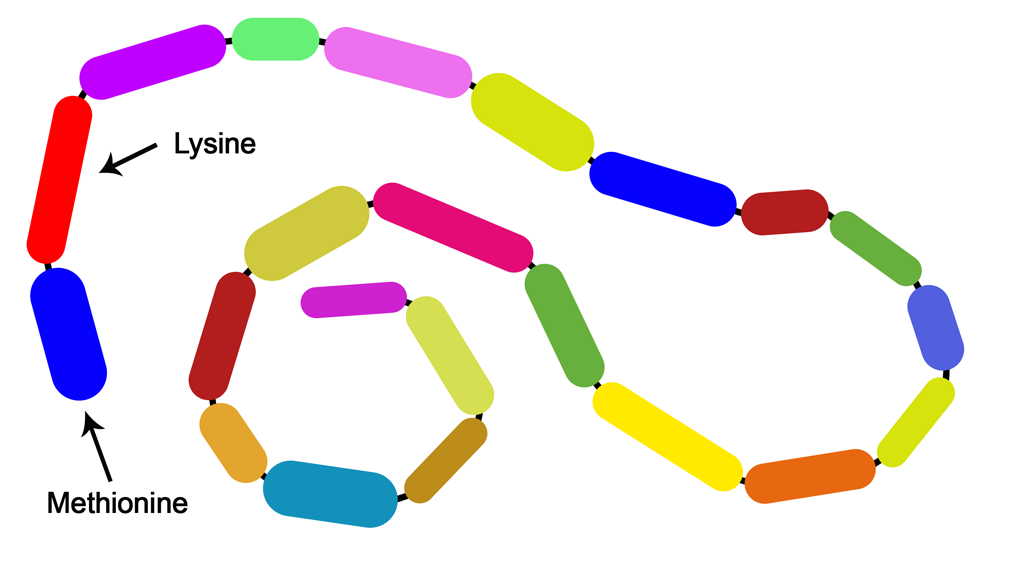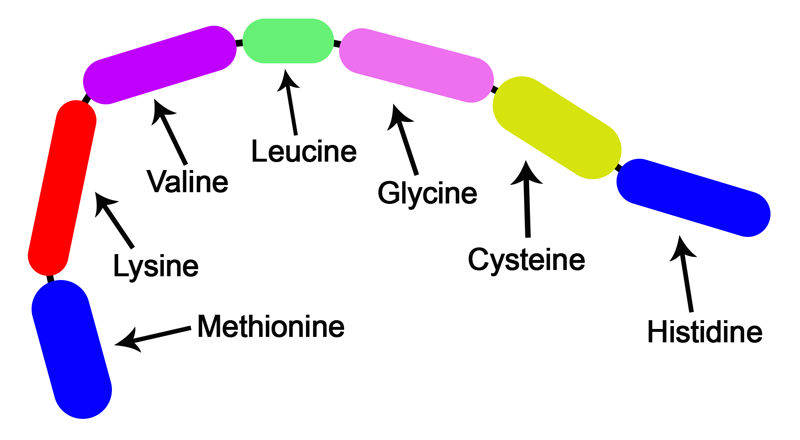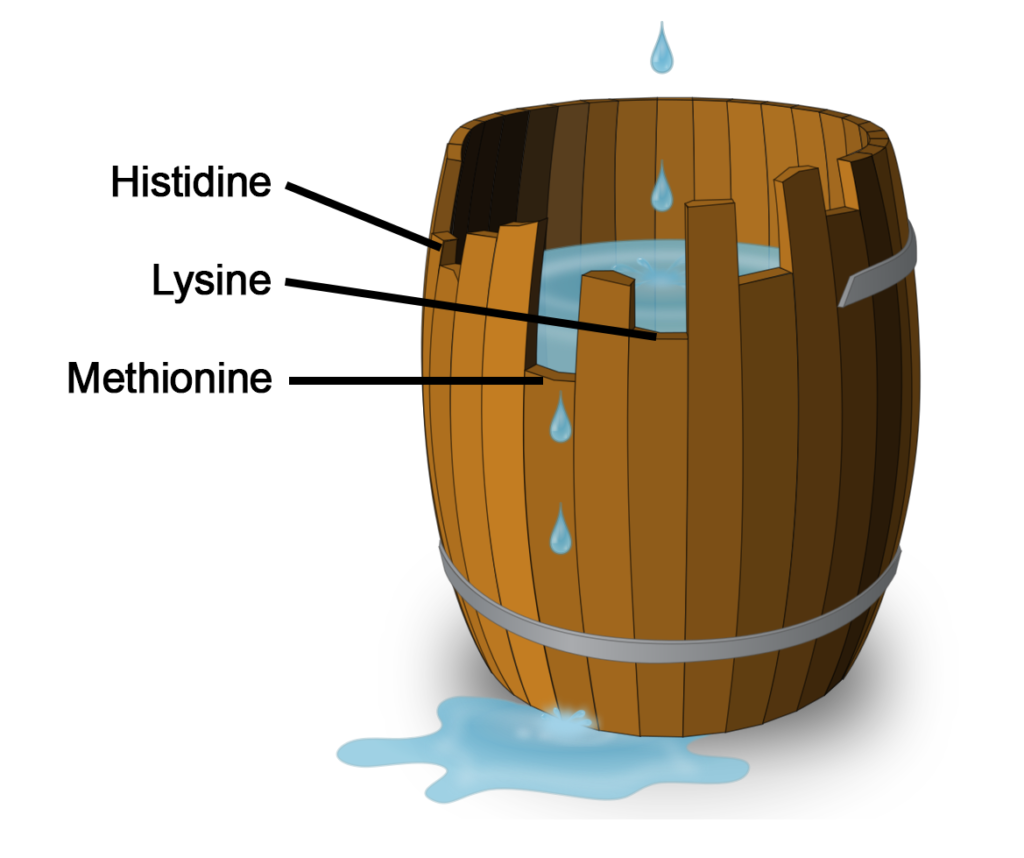Why are they important to me? and, why do I need to know?
What is in it for me?
Some of you will already have a good working knowledge of this subject but there are many farmers and students who find it all a bit too much and would rather just trust that their feed company and nutritionist will sort it all out without them having to think about it.
I guess that delegating the technical stuff is a good solution for many but “Knowledge is Power” as they say and this little piece of nutrition can open up the potential of animals to perform even better and improve profits at the same time.
I have spent years talking about this “stuff” and I think that breaking it down to simple logic is the best way of explaining it. Then my son Richard said, “It could be done with sausages!” so here goes: –
Note this is not strictly biochemically accurate but it does cover the simplified theory!
What are amino acids?
Imagine that a protein is like a piece of string.
There are millions of different proteins but they all look like pieces of string!
All proteins are made up of chains of amino acids.
An amino acid is an organic compound containing amino (–NH2) and carboxyl (–COOH) functional groups. They also have a side chain (R group) which is specific to each amino acid and makes them all different.
The key elements of an amino acid are carbon (C), hydrogen (H), oxygen (O), and nitrogen (N).

Why are amino acids important? and, why do I need to know?
Theoretically there are many different amino acids (“sausages!”) but of these only 22 are really important. In order to make a complete protein all 22 have to be present.
The different proteins contain all of the 22 key amino acids but in different orders (sequences).
Complex proteins can be made up of several chains and may contain many more than the 22 key amino acids.
The amino acids form little strings called peptides and when they all become bonded together to form a protein, they are polypeptide chains (more than two peptides) !
The 22 amino acids are naturally incorporated into polypeptides and are called proteinogenic or “Key” natural amino acids. See figure 1.
Figure 1
Two similar but different theoretical protein amino acid chains:


The different positions of the two named amino acids Lysine and Methionine indicate that these are two different protein structures.
Of the 22, 20 are encoded by the universal genetic code.
The remaining 2 are Selenocysteine and Pyrrolysine, are incorporated into proteins by unique synthetic mechanisms.
Peptides are basically slices of the protein string (amino acid chain). See figure 2.
Figure 2
A theoretical simple Tripeptide

A theoretical more complex oligopeptide

Peptides are short chains of between 2 and 50 amino acids, linked by peptide bonds. Small chains of less than 10 or 15 amino acids are called Oligopeptides, and include Dipeptides, Tripeptides, and Tetrapeptides. Sometimes the more simple peptides can be formed using the same amino acid. ie: – 3 lots of glycine.
A polypeptide is a longer, continuous peptide chain of up to approximately fifty amino acids.
Peptides are described as biological polymers and oligomers, alongside nucleic acids, oligosaccharides, polysaccharides, and others but now we are getting technical!
A protein is a polypeptide that contains more than approximately fifty amino acids.
Proteins consist of one or more polypeptides arranged in a biologically functional way.
The sequence of amino acids in insulin was discovered by Frederick Sanger, establishing that different proteins have defining amino acid sequences.
Insulin is composed of 51 amino acids in 2 chains. One chain has 31 amino acids, and the other has 20 amino acids. (The whole protein will contain all 22 key amino acids.)
Insulin is a relatively simple protein but there are many structures of protein with the amino acid chains forming many different structures.

From Wikipedia
The 22 Key amino acids are the ones that we nutritionists concentrate on because we know that if any are missing, the performance of the animal will be reduced.
Of the 22, nine of them are essential which means that they cannot be synthesised by the animal itself and so they have to be supplied in the diet.
The essential amino acids are therefore the most important ones and are the focus of attention by nutritionists for all livestock enterprises.
They are lysine, methionine, isoleucine, leucine, phenylalanine, histidine, threonine, tryptophan, and valine.
Of these Methionine and Lysine are normally the first two limiting amino acids. This means that in order to boost performance they will be the first two amino acids that have to be added to the diet. In the case of dairy cows these amounts are very small indeed but the effect can be highly significant.
In 2017, CG Schwab cited methionine, lysine and histidine as the first three and some sources also quote leucine for dairy diets.

In 2019 research in China confirmed that for growing cattle, the first three limiting amino-acids are lysine, methionine and threonine, with the ratios of the three stated as 100:32:57. The ratios indicate that the growth tissues for the seven to nine month old holstein heifers on trial, gave the best response when they received enough of each of the essential amino acids in this ratio. Any excess would have been excreted.
The simple example of the leaky barrel is a great way to visualise this.
Plugging the lowest leak on the side of the barrel will give a boost to the amount of water the barrel will hold. There is no point in plugging any of the leaks at higher points until that lowest one is sealed, because the barrel will always only fill to the lowest point.
Non-essential amino acids include glycine, cysteine, alanine, arginine, asparagine, aspartic acid, glutamic acid, glutamine, proline, serine, and tyrosine.
Note: – glycine and cysteine (which are commonly used to (protect copper, zinc, and manganese as in the form of glycinates) are not essential amino acids. (Which is another reason why I prefer the methionates and proteinates which are based on methionine which is an essential amino acid!)
So that is the basics of how amino acids and proteins are linked and why we need to think about protein quality to supply enough of the limiting essential amino acids so that we can exploit the potential of and improve the health and fertility status of our animals.
What’s in it for me ?
The focus on global warming and reducing carbon footprints has prompted the consumer industry to increase demand for lower carbon footprint products.
Most farmers are aware of this and the drive to reduce imported soyabean meal imports. This is a worthy ambition but Soyabean meal is one of the richest pant-based sources of the key amino acids and in particular lysine and methionine.
Farmers are also aware of the focus of many in the feed industry to switch from soyabean meal to oil extracted rapeseed meal. There are a few issues with this change, and it has naturally prompted the industry to look at other possible substitutions.
All nutritionists should be aware that microbial crude protein (MCP) or rumen microbes themselves, are the richest source of the essential and key amino acids that the cow or sheep can receive.
This means that the first priority of any diet regime should be to optimise rumen function and output of MCP.
There are some great ways of helping the cow or sheep to achieve this.
- First step is to balance the diet for all of the major nutrients and minerals.
- The second step is to adjust the diet for rumen Ph and buffering capacity.
- The third step is to reassess the major protein inputs for essential amino acid supply and carbon footprint issues.
- The fourth and some would say most important step is to use the essential amino acid supply data to re-balance the overall protein inclusion.
This last step will usually enable a cutback overall crude protein supply which in turn will reduce the carbon footprint and the diet costs. Not only will this be possible, in most cases there will also be an improved production response.
Now, I know that dairy, beef, and sheep husbandry systems are subject to many other effects like environment, genetics, routine management, and other variable influences, but we should aspire to create healthy diets.
Products that can help include the following: –
- F 1 Yeast
- Metasmart or Smartamine
- Optigen 2
- Nitroshure
- Novatan
- Rumen Buffers like Acidbuf, Vitalbuf and Sodium Bicarbonate
- Novapro
All of these products have great proofs and are published and peer reviewed.
Our web site contains much more detail on the products mentioned above and in some cases links to more detailed papers.
